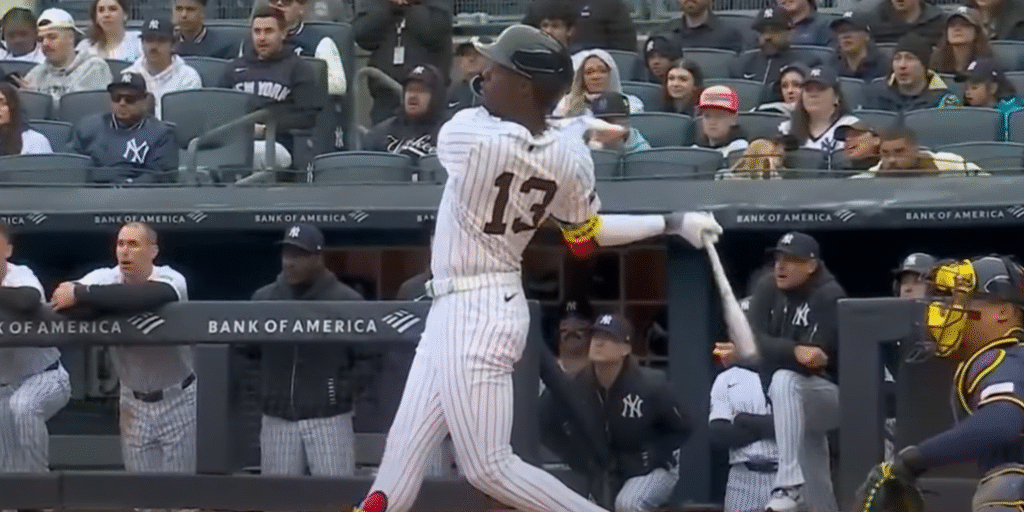Baseball’s most iconic piece of gear has quietly experienced one of its biggest revolutions. The now-famous “torpedo” designs of modern bats have evolved into performance instruments as meticulously designed as Formula 1 cars. These bats are revolutionizing how offense is constructed by shifting weight, improving materials, and utilizing data analytics. They are also altering how players swing.
It has been especially evident in the last few weeks. From seasoned players like Giancarlo Stanton to up-and-coming talent like Anthony Volpe, players in the league have been utilizing redesigned bats that move mass closer to the sweet spot of the barrel. Despite its subtle appearance, this adjustment is incredibly effective at increasing swing and exit velocities. Because the design creates a more streamlined path through the strike zone, the effect has been especially apparent for hitters who prioritize accuracy over strength.
The unusual “torpedo” shape was first brought up by Yankees broadcasters during a spring training game, and it set off a quick, almost cinematic, chain of events. In a matter of hours, videos of home runs made with these bats went viral on social media, igniting interest and enthusiasm. There was a modern baseball frenzy that ensued, with players asking for customized versions, manufacturers being inundated with orders, and analysts questioning whether technology was finally giving hitters a much-needed advantage.
Baseball Equipment Evolution – Key Figures and Information
| Category | Details |
|---|---|
| Innovation Focus | Modern “Torpedo” Bat Design |
| Primary Developers | Victus, Hillerich & Bradsby (Louisville Slugger) |
| Notable Users | Giancarlo Stanton, Jazz Chisholm Jr., Anthony Volpe |
| Material Used | Maple, Birch, and Hybrid Composites |
| Key Feature | Mass shifted toward the sweet spot for optimized power |
| Origin of Design | MLB Analytics Teams and MIT Engineering Consultants |
| Industry Reaction | Widespread adoption across MLB by mid-2025 |
| Official Status | Approved under MLB regulations |
| Cultural Impact | Sparked debate over fairness, physics, and hitting balance |
| Reference | ESPN: Inside the Torpedo Bat Era |

The use of sophisticated analytics has allowed batmakers to create extremely customized models for every player. High-speed cameras, motion sensors, and biomechanical data are used to identify a player’s usual point of contact and the way their wrists move during a swing. The procedure is incredibly straightforward and effective: the wood is shaped by the hitter’s inherent mechanics. For athletes who struggle with timing or consistency, this customized approach has proven especially helpful because even minor changes can result in noticeably better performance at the plate.
A change in philosophy is also evident in the rise of the torpedo bat. The natural connection between a player and wood, known as feel, has long been prized in baseball. However, the contemporary method adds science as a silent partner to that partnership. The way that professional golfers now use customized clubs is comparable; the tools used by each player are determined by their own rhythm and stance. For batters like Jazz Chisholm Jr., who thrives on quick reflexes and powerful torque, the new bat is more than just a piece of gear; it’s a manifestation of who he is on the field.
Manufacturers have reacted to this surge with remarkable agility, including Victus and Louisville Slugger. Less than a week after the new bats were first mentioned on television, Victus CEO Jared Smith reported that demand had tripled. While this was going on, Louisville Slugger’s artisans put in endless hours honing their designs to ensure legality and maximize efficiency. “The most intense innovation wave since aluminum bats were introduced in college ball decades ago,” another executive said of the phenomenon.
It is especially inventive in its design. The bat can accelerate through the hitting zone more quickly while keeping balance by focusing weight on the area of most frequent contact. Simple but remarkably effective physics: a closer transfer of energy between bat and ball. This minor but significant change results in increased control, decreased vibrations, and longer flight distances.
The ball simply leaps, as Giancarlo Stanton put it, “like catching lightning.” Other players found resonance in his words, which encouraged experimentation among teams. In less than a month, prototypes had been requested by almost all MLB organizations. Others, like Alex Bregman, went back to more conventional models, reminding everyone that comfort is still just as important as technology, while other players quickly adjusted.
On the other hand, the public’s response has been tremendously positive. Faster games and soaring home runs are spectacles that fans adore. In markets like New York and Los Angeles, where the bat’s early adopters produced offensive records, television ratings have mirrored that enthusiasm. According to analysts, offensive output in April 2025 increased by about 10% over the same period the year before, which is a significant indication of the design’s potential.
The innovation has deeper significance than just entertainment. It draws attention to the ways that data-driven thinking has influenced every facet of professional sports. Baseball’s analytical renaissance is beginning, much like how basketball adopted shot analytics and tennis improved racquet string science. The modern bat is a living example of that change, having been meticulously engineered. It represents advancement and demonstrates how tradition and technology can coexist harmoniously.
Naturally, there are skeptics. While some pitchers contend that the new bats make offense overwhelmingly dominant, traditionalists worry that engineering will replace artistry. Most people in the sport, however, believe that the change is unavoidable and even essential. It was necessary to adjust the ratio of hitting to pitching as strikeout rates increased in recent years. Because the torpedo bat gives hitters a slightly sharper edge, it has at least momentarily restored that balance.
The similarities are not limited to sports. The trend toward customization is consistent with broader consumer culture trends, such as customized diets and running shoes. Similar to other contemporary professionals worldwide, athletes yearn for tools that express their unique style. The new baseball bat is therefore a product of identity rather than physics. It feels especially empowering and incredibly effective when players take ownership of their craft.
